When you have a plan to visit Italy, sometimes the unexpected can happen. For us, on our road trip through northeast Italy, Terry’s father sent a message. Did we know how close we would be to the Prisoner of War camp, Campo PG 57.
During WWII many prisoners of war camps existed in Italy to hold allied prisoners who had been captured during the conflict.
In one of those camps, POW Campo PG 57, Terry’s paternal grandfather John McKenna was held captive.
Consequently, on our way from Bologna to Trieste, we took a detour from the main highway and headed north to Udine.
Where is POW Campo PG 57?
The largest city near Campo PG 57 is Udine in the Friuli–Venezia Giulia region of Italy. And it’s near the smallest town of Grupignano.
From Udine, take the road Via Cividale (SS54) to the round-about at the intersection of SP79. Turn right in the direction of the small hamlet, Borgo San Mauro. The entrance to Campo PG 57 is 700m on the left of SP79.
As we drove the road in the direction of Grupignano, we couldn’t help but reflect on how lucky we are to live in times that allow us to move with freedom around so many countries of the world.
Terry’s grandfather never had that luxury. Like many in that era, he spent time fighting in battles where many of his friends lost their lives, or like him, their freedom.
Chapel of POW Campo PG 57
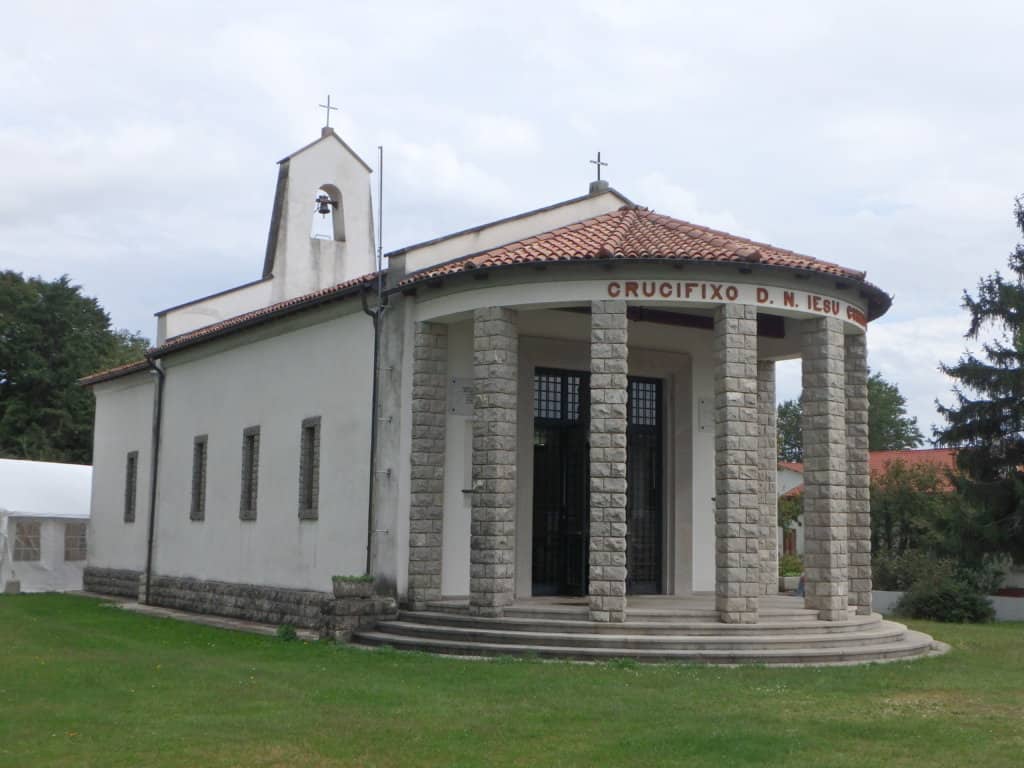
The entrance to what was once Campo PG 57, is a driveway between some farmhouses. And our first sight was a Chapel sitting in a large field.
Just as we arrived at the chapel, an elderly lady was walking by on her way to a market. She noticed us looking at the chapel.
After a few minutes of exchanging our terrible Italian, with her non-existent English, she disappeared back into her home.
A few minutes later her husband joined us with a set of keys, and let us into the chapel.
During their time of imprisonment, POWs built a chapel. It is the only building left of the POW Campo PG 57.
We spent time looking around the chapel, reading the visitors book, and leafing through a folder. The folder contained details of the history of the camp and the chapel.
But what we really wanted to see in the chapel was the crucifix Kevin had told us about. It had been made by the POWs, and some of the men had signed the back of the crucifix.
POW Signatures on Chapel Crucifix
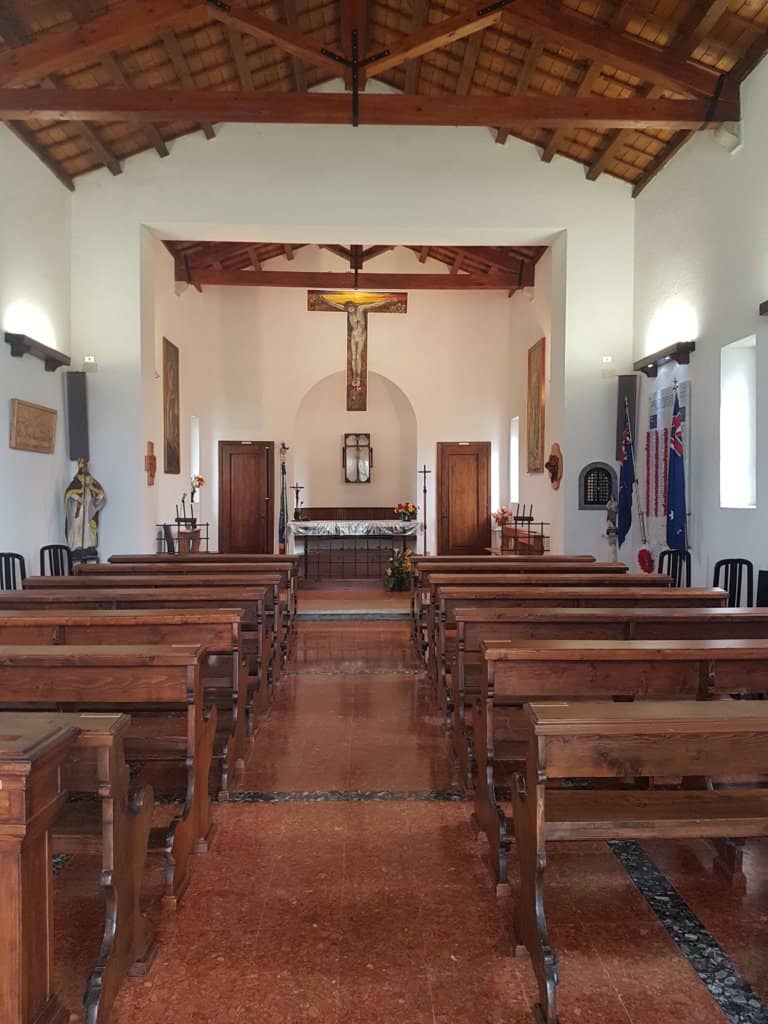
We eventually asked the caretaker about the crucifix. He pointed to a glass-encased cross hanging on the wall behind the altar.
With Terry’s help, he took it down from the wall, turned it around and sure enough the signatures were there.
We took some photos of the signatures that didn’t come out due to the reflection of the glass. But we did take a video and have uploaded it to our new YouTube channel.
You can view it here Crucifix Video.
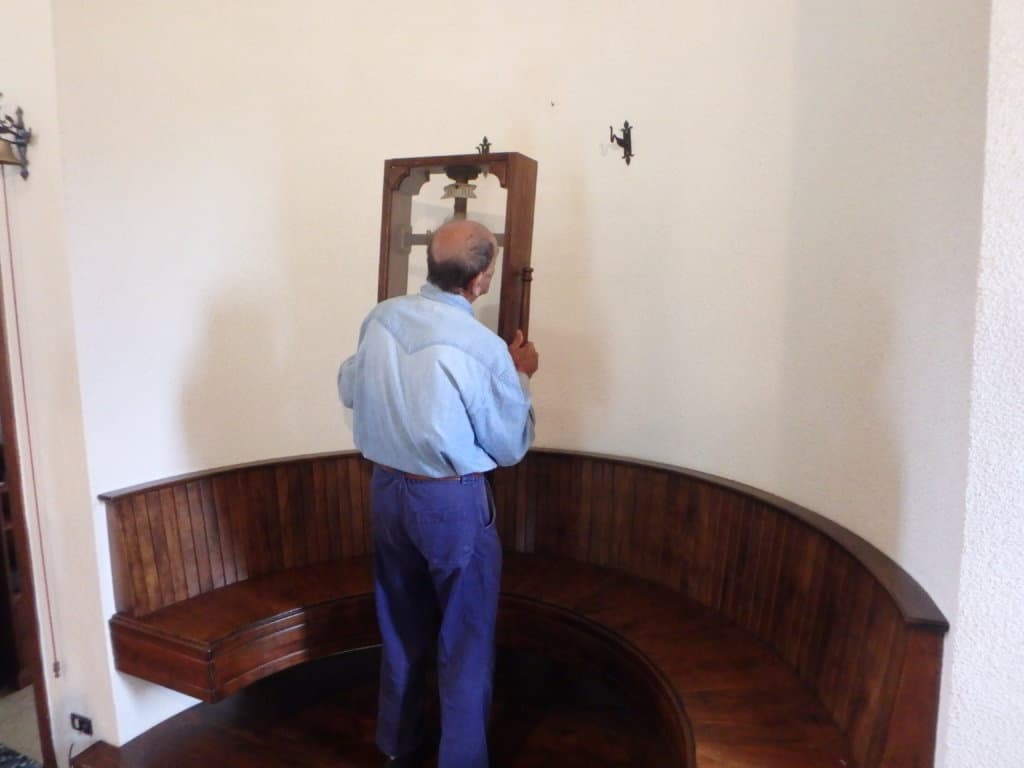
Restoration of the Chapel of POW Campo 57
After World War II, the chapel had become neglected.
However, in the 1980s a group of Italian men called The Anglet restored the chapel.
The Anglet motto is “with an aim to keep alive the sense of solidarity among military personnel on leave and those in service.”
The men volunteered their time, materials and skills to restore the chapel. It was in recognition of what it represented to those men who built it many years ago.
Here is a link to the article written about the restoration of Campo 57.
When reading about the restoration, we found a letter from Ambrose Loughnan. He was 23 years old when he attended the first mass in the chapel.
Ambrose later became a Dominican missionary priest serving in the Soloman Islands (where Maura’s father was based in WWII).
Fr Ambrose returned 50 years later to Campo PG 57 to celebrate mass for the restoration of the chapel.
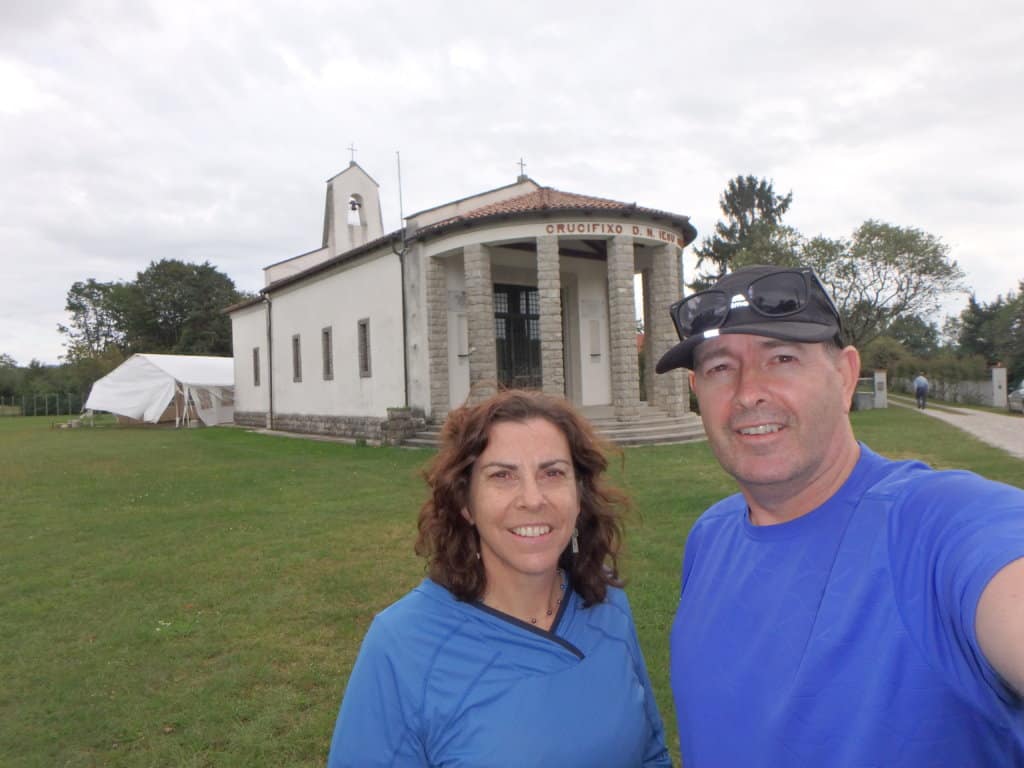
Campo PG 57 Websites
For more information on Campo PG 57, click on the links below:
And here is a story of a soldier who spent time in Campo PG 57.
43205 Private John Stuart Alphonsus McKenna
Terry asked his father to provide some background on John McKenna’s WWII experience. The following is what Kevin wrote:
I was two years of age when on 25 January 1941 my father and Terry’s grandfather, John Alphonsus Stuart McKenna, volunteered for war service and joined the 2nd NZ Expeditionary Force (2NZEF).
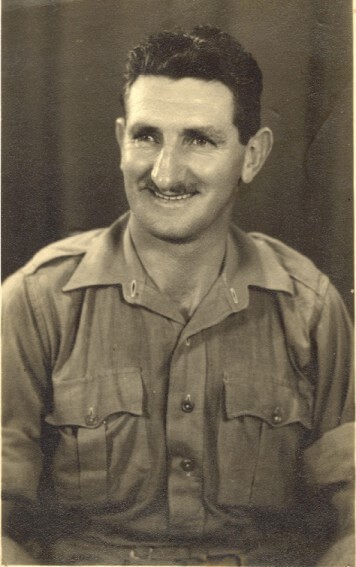
John entered Trentham Camp, Wellington, New Zealand (NZ) on 18 February 1941 and embarked for Egypt on 7 April 1941 as a member of the 5th Reinforcements.
The ship Nieuw Amsterdam left Wellington, New Zealand for the Middle East via Sydney, Perth, Singapore and Colombo, Ceylon (now Sri Lanka).
The ship disembarked in Egypt on 16 May 1941. And on 26 June 1941, John joined the Taranaki Company, the 19th Battalion, 4th NZ Brigade Group, 2nd NZ Division.
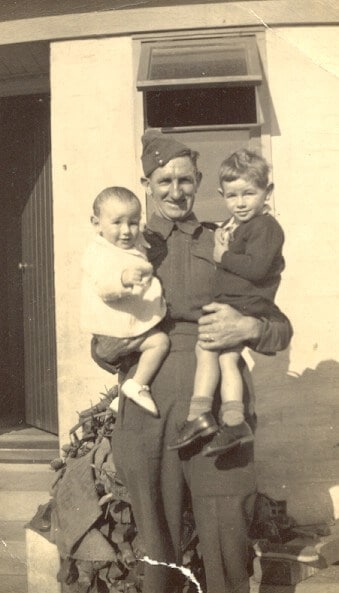
John began desert training at the Infantry Training Depot, 2 NZEF Base Camp at Maadi on 27 September and marched back into the 19th Battalion on 19 October 1941. He was in the 1941 Op Crusader battles for Tobruk.
During the famous 1942 Break-Out at Minqar Qaim, he was in the leading company.
At the Battle of Ruweisat Ridge is where the 4th NZ Brigade, particularly the 19th Battalion was decimated. John was captured by the Germans on 15 July 1942, the same battle in which Keith Elliot was awarded his Victoria Cross (VC) and Charles Upham his second VC.
15 July 1942 – last day of the battle, John was posted missing.
24 October 1942 – a cable from The Vatican stated John was incarcerated at Campo PG 57 at Grupignano.
25 October 1942 – posted as a Prisoner of War (POW)
24 July 1943 – a communication was received from Rome stating John was in Campo PG 103/7 at La Maina (Sauris) in the Dolomites. He was put to work on a hydroelectric scheme.
April 1943 – cables from Rome advised that John had been ill with chronic intestinal catarrh. He was discharged from the Hospital Militaire at Udine. Cured of the illness but in organic decline.
15 September 1943 – arrived at Stalag VIIA at Moosberg following a transfer from Campo PG 103/7 after the Italian surrender.
3 November 1943 – John moved to Stalag XIA, Altengrabow, near Magdeburg.
24 December 1943 – John was moved to Stalag XIB at Fallingbostel.
25 December 1943 – John was moved to work camp KDO 7002 at Ufingln. He worked building air-raid shelters (camp attached to Stalag XIB)
6 August 1944 – John was moved to Arbeitskommando 7001 at Halendorf where he worked in a steelworks until 9 April 1945 (camp attached to Stalag XIB)
13 April 1945 – the German commandant of Stalag XIB announced that the British forces were very close. He proposed to move his guard company, leaving a token guard on the camp to avoid possible interference by SS troops in the area.
Senior prisoner NCOs then took over the complete administration of the camp, even issuing leave passes to the German guards.
16 April 1945 – British tanks of units of the 7th Armoured Division (the Desert Rats) arrived at the camp gates. The POWs were released from Stalag XIB at 0837 hours on that day.
23 April 1945 – John’s Army records show him as safe in the UK
18 June 1945 – John embark in England and arrived back in NZ on 19 July 1945
I can remember being at the Patea Railway Station when the troop train arrived. People were cheering and waving. Soldiers hanging out the train windows waving back. And then this big soldier came up and hugged us.
Dad was home from the war.
That night he unpacked his kit bag. He had a Swastika flag, a German SS belt buckle and other souvenirs he had nicked from the Camp Commandant’s office when the Camp was liberated. He also had a huge cake of chocolate which was in a tin. I think he said it was from a German army ration pack. It was delicious.
Dad never talked about those years. But reading the Official History of NZ Prisoners of War, and other books, there is no doubt that all prisoners of war suffered from poor food; bad living conditions and inadequate medical services.
Major General Kippenberger in his forward to the official NZ war history “Prisoners of War” wrote:
“I saw those who came out of Germany after the war ended. They were thin and strained, but they carried themselves as soldiers and as men who knew they had acquitted themselves as men in a long and bitter ordeal. I was proud that I had served with them in the hard years.”
John McKenna died on 12 May 1968 at the young age of 58, a few months after I returned to New Zealand with my family. I had just completed a two year Tour of Duty with the NZ Army in Singapore.
I later discovered a cousin of my mother’s, 16899 Pte A. McD. Cochrane had also been in Campo PG 57. As well as each of the German POW camps, with Dad.
It is very warming to me that Terry, my youngest son, has visited Campo PG 57, and my eldest son Michael has visited the site of Stalag XIB.
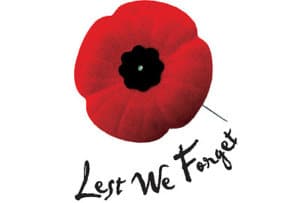

Hi
You may like to check out my fathers war records at website robwoolcott.com as I believe John and my dad rob were best mates and spent a few years together in various pow camps
Thanks Errol, we will do that and also pass it on to my father Kevin, John’s son.